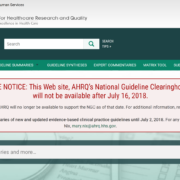
Maintenance downtimes warrant scrutiny, but experts say they’re probably reasonable and necessary.
Continue readingHHS to shut down public medical guideline database, go-to for physicians

The key website for curating medical guidelines, widely used by medical professionals, was scheduled to go offline on July 16. HHS cites budget cuts as the reason.
Continue readingThe Political One Percent of the One Percent: Megadonors fuel rising cost of elections in 2014
In the 2014 elections, 31,976 donors — equal to roughly one percent of one percent of the total population of the United States — accounted for an astounding $1.18 billion in disclosed political contributions at the federal level.
Continue readingWomen make up more than half the U.S. population, less than one fourth of U.S. House witnesses
Fewer than one quarter of the witnesses testifying before House committees during the current session of Congress are women, a Sunlight analysis of newly available data shows.
Continue readingCongress API revamps during recess
Congress has been at recess, but here at the Sunlight Foundation we have been working hard to improve our Congress API! There two new endpoints that make congressional and accountability documents searchable, and more information about hearings and legislators.
Continue readingSunlight’s Foreign Influence Explorer influences DOJ policy
When Sunlight and our coalition partners were invited to meet with Associate Attorney General Tony West in April to discuss transparency initiatives, FARA reform was what Sunlight brought to the table. And, perhaps to some surprise, it has led to some tangible results.
Continue readingData and creativity: A response to Timothy Egan
New York Times columnist Timothy Egan argues that the move towards data journalism is somehow opposed to creativity. I must object; data analysis and everything that goes into it can be highly creative.
Continue readingWhat’s New in the Sunlight Congress API
In January, Sunlight [released a new Congress API](https://groups.google.com/forum/#!topic/sunlightlabs/r-evxgtFXRw). It's been a huge help to [our own products](http://congress.sunlightfoundation.com/), and seen a great deal of use by the community (such as today's [DefundTheNSA campaign](http://defundthensa.com/)). In the time since, we've released some new data, some new developer-friendly features, and seen lots of community contribution. Here's what's been added over the last few months:
Continue readingFilming OpenGov Champions: Marko Rakar, Zagreb, Croatia
You cannot hang around the global OpenGov and transparency community without running into Marko Rakar. This open data activist ended up creating so much change in his native country of Croatia that he is now a close consultant to the country’s current president in all matters of politics. His story is so inspiring that even though we focus mostly on the open government movement in the U.S. in our OpenGov Champions series, I wanted to nominate him as our next Champ. He is a great example of making big change happen through fairly simple actions.
Continue readingAre the 1% of the 1% pulling politics in a conservative direction?

In the 2012 election 28 percent of all disclosed political contributions came from just 31,385 people. In a nation of 313.85 million, these donors represent the 1% of the 1%, an elite class that increasingly serves as the gatekeepers of public office in the United States.
The more conservative the Republican, the more dependent that Republican is likely to be on the nation's biggest individual donors, a new Sunlight Foundation analysis of campaign finance data finds. By "biggest individual donors," we are referring to a group we named “the 1% of the 1%” after the share of the U.S. population that they represent. These wealthy donors may be pulling Republicans to the political right, acting as a force for a more polarized Congress. The polarizing effect for Democrats, meanwhile, is unclear. If anything, more liberal Democrats depend a little less on 1% of the 1% donors than conservative Democrats. As we explored in our big-picture look at the 1% of the 1%, the biggest donors in American politics tend to give big sums of money because they want one party to win. Approximately 85 percent of the top individual donors in U.S. politics contributed at least 90 percent of their money to one party or the other. By contrast, less than four percent of these donors spread their money roughly equally between the two parties (a 60-40 split or less).
Figure 1.
 The above figure treats all Democrats and Republicans as equivalent. In reality, both parties contain some moderates and some extremists. Some -- Ezra Klein, most prominently -- have argued that while small money exerts a polarizing tug on the parties, big money is consensus-oriented and centralizing. At the time, I responded that if big money was consensus-oriented, it was doing a terrible job of building consensus. I went further to hypothesize that big money might also be polarizing. Turns out I was more right than I knew then.
Continue reading
The above figure treats all Democrats and Republicans as equivalent. In reality, both parties contain some moderates and some extremists. Some -- Ezra Klein, most prominently -- have argued that while small money exerts a polarizing tug on the parties, big money is consensus-oriented and centralizing. At the time, I responded that if big money was consensus-oriented, it was doing a terrible job of building consensus. I went further to hypothesize that big money might also be polarizing. Turns out I was more right than I knew then.
Continue reading

